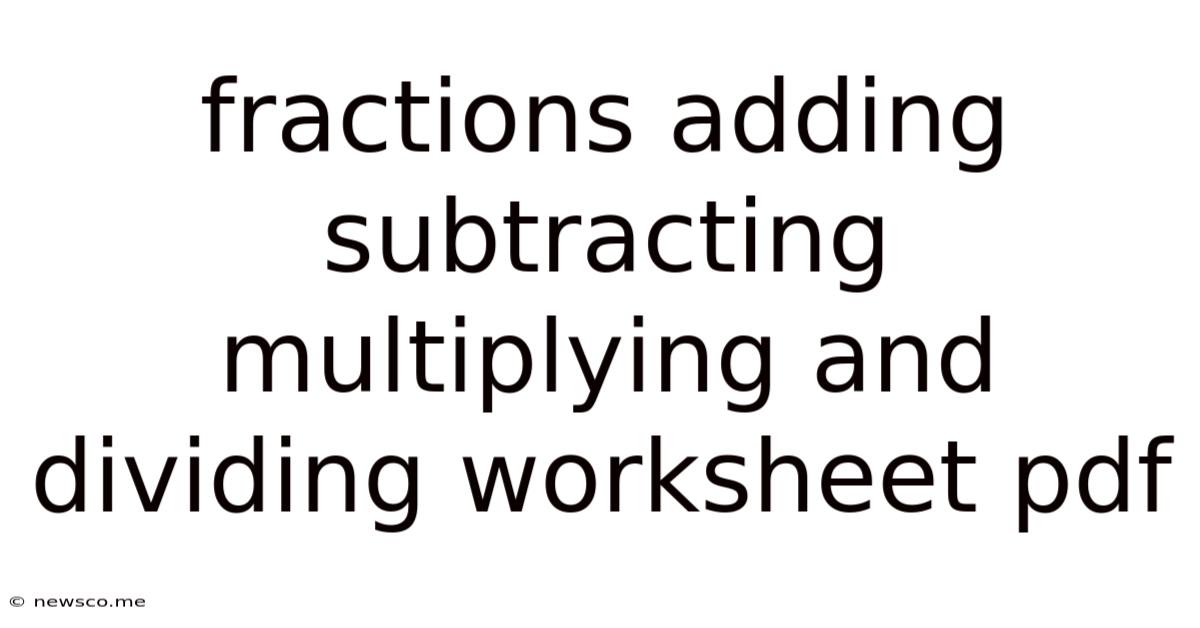Fractions Adding Subtracting Multiplying And Dividing Worksheet Pdf
News Co
Apr 17, 2025 · 4 min read

Table of Contents
Fractions: Adding, Subtracting, Multiplying, and Dividing Worksheets (PDF) – A Comprehensive Guide
Mastering fractions is a crucial stepping stone in mathematics. Understanding how to add, subtract, multiply, and divide them forms the foundation for more advanced concepts in algebra, calculus, and beyond. This comprehensive guide delves into the intricacies of fraction operations, offering valuable insights and practical strategies to improve your skills. We’ll also explore where to find and utilize helpful worksheets (PDF format) to solidify your understanding and practice your skills.
Understanding Fractions
Before diving into the operations, let's refresh our understanding of what a fraction represents. A fraction is a part of a whole. It's expressed as a ratio of two integers: the numerator (the top number) and the denominator (the bottom number). The denominator indicates the total number of equal parts the whole is divided into, while the numerator specifies how many of those parts are being considered. For example, in the fraction 3/4, the numerator is 3 and the denominator is 4. This represents 3 out of 4 equal parts.
Types of Fractions
- Proper Fractions: The numerator is smaller than the denominator (e.g., 2/5, 1/3).
- Improper Fractions: The numerator is equal to or larger than the denominator (e.g., 7/4, 5/5).
- Mixed Numbers: A combination of a whole number and a proper fraction (e.g., 2 1/2, 3 3/4). Improper fractions can be converted to mixed numbers and vice versa.
Adding Fractions
Adding fractions requires a common denominator. If the fractions already have the same denominator, simply add the numerators and keep the denominator the same.
Example: 1/5 + 2/5 = (1+2)/5 = 3/5
If the denominators are different, you must find the least common multiple (LCM) of the denominators. This becomes the new common denominator. Convert each fraction to an equivalent fraction with the common denominator, then add the numerators.
Example: 1/3 + 1/4
The LCM of 3 and 4 is 12.
1/3 = 4/12 (multiply numerator and denominator by 4) 1/4 = 3/12 (multiply numerator and denominator by 3)
4/12 + 3/12 = 7/12
Subtracting Fractions
Subtracting fractions follows a similar process to addition. Ensure the fractions have a common denominator. Then, subtract the numerators and keep the denominator the same.
Example: 5/8 - 2/8 = (5-2)/8 = 3/8
If the denominators are different, find the LCM, convert to equivalent fractions, and then subtract.
Example: 2/3 - 1/6
The LCM of 3 and 6 is 6.
2/3 = 4/6 (multiply numerator and denominator by 2) 4/6 - 1/6 = 3/6 = 1/2 (simplify the fraction)
Multiplying Fractions
Multiplying fractions is simpler than adding or subtracting. Simply multiply the numerators together and multiply the denominators together.
Example: 2/3 * 1/4 = (21)/(34) = 2/12 = 1/6 (simplify)
Dividing Fractions
Dividing fractions involves inverting (reciprocating) the second fraction (the divisor) and then multiplying.
Example: 2/3 ÷ 1/4 = 2/3 * 4/1 = (24)/(31) = 8/3
Working with Mixed Numbers
When adding, subtracting, multiplying, or dividing mixed numbers, it’s generally easier to convert them into improper fractions first. Then perform the operation as described above, and finally, convert the result back into a mixed number if needed.
Example (Addition): 2 1/2 + 1 1/4
Convert to improper fractions: 2 1/2 = 5/2 and 1 1/4 = 5/4
Find the LCM of 2 and 4, which is 4.
5/2 = 10/4 10/4 + 5/4 = 15/4
Convert back to a mixed number: 15/4 = 3 3/4
Using Fractions Worksheets (PDF)
Practice is key to mastering fractions. Numerous online resources provide free printable worksheets (PDF format) covering a wide range of difficulty levels. These worksheets typically include a variety of problems focusing on:
- Simplifying Fractions: Reducing fractions to their lowest terms.
- Converting Between Fractions, Decimals, and Percentages: Building a strong understanding of these interconnected representations of numbers.
- Comparing Fractions: Determining which fraction is larger or smaller.
- Word Problems: Applying fraction operations to solve real-world scenarios.
Finding Worksheets: Search online for "fractions worksheets PDF" or "fraction addition subtraction multiplication division worksheets PDF." Many educational websites and resources offer free and printable materials.
Tips for Success
- Start with the basics: Ensure you thoroughly understand the fundamental concepts before moving to more advanced problems.
- Practice regularly: Consistent practice is essential for mastering fraction operations.
- Use visual aids: Diagrams and illustrations can help you visualize the concept of fractions and make the operations easier to understand.
- Check your work: Always verify your answers to ensure accuracy.
- Seek help when needed: Don’t hesitate to ask for assistance if you are struggling with any aspect of fractions.
- Break down complex problems: If a problem seems overwhelming, break it down into smaller, more manageable steps.
Conclusion
Mastering fractions is a crucial step in building a solid mathematical foundation. By understanding the fundamental principles of adding, subtracting, multiplying, and dividing fractions, and by utilizing practice worksheets (PDF), you can develop confidence and proficiency in this essential area of mathematics. Remember, consistent effort and practice are key to success. Utilize the abundant resources available online, and you'll be well on your way to mastering fractions. Good luck!
Latest Posts
Related Post
Thank you for visiting our website which covers about Fractions Adding Subtracting Multiplying And Dividing Worksheet Pdf . We hope the information provided has been useful to you. Feel free to contact us if you have any questions or need further assistance. See you next time and don't miss to bookmark.